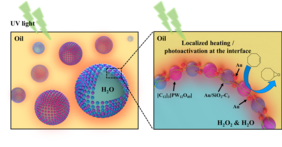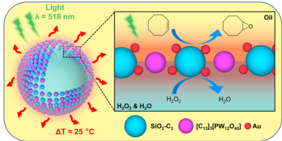Hot, the plasmons ! Oxidation in emulsion
DYSCO Actualités scientifiques Vie du labo Parutions
Through localized surface plasmon resonance, noble metal nanoparticles (NPs) can absorb light to generate hot electrons and cause local heating by hyperthermia. These properties enable efficient light-to-energy conversion and energy transfer to the local microenvironment around the plasmonic NPs. Unlike conventional heating, plasmon-driven catalysis involves hot electrons and/or a temperature gradient at the catalyst surface under light irradiation to accelerate activity and alter reaction selectivity by activating specific chemical bonds.
In the framework of an interdisciplinary collaboration between the Cardiff Catalysis Institute, and the UCCS laboratories, LASIRe and PhLAM of the University of Lille, a new light-driven catalytic system has been developed. It is based on a Pickering emulsion allowing the oxidation of olefins at mild temperature. The system uses a colloidal tectonics approach to prepare the emulsions, involving the interfacial self-assembly of two surface active particles with complementary hydrophilic/hydrophobic groups.
The system exhibits a 5-fold increase in activity over the thermal reaction for room temperature oxidation of alkenes with H2O2. This study opens a pathway for the design of multiphase photoreactors for mild-temperature oxidation reactions, with a potential energy saving of 74% compared to that of thermally heated reactors at isoconversion.
This work has just been published recently (January 2023) in the journal Green Chemistry (IF 11): https://pubs.rsc.org/en/content/articlelanding/2023/gc/d2gc04591e and on the CNRS Website : https://www.inc.cnrs.fr/fr/cnrsinfo/des-electrons-chauds-pour-une-oxydation-tout-en-douceur
Y. Feng, J.-F. Dechezelle, Q. D'Acremont, E. Courtade, V. De Waele, M. Pera-Titus and V. Nardello-Rataj, Light-driven Pickering interfacial catalysis for the oxidation of alkenes at near-room temperature, Green Chem. (2023)


